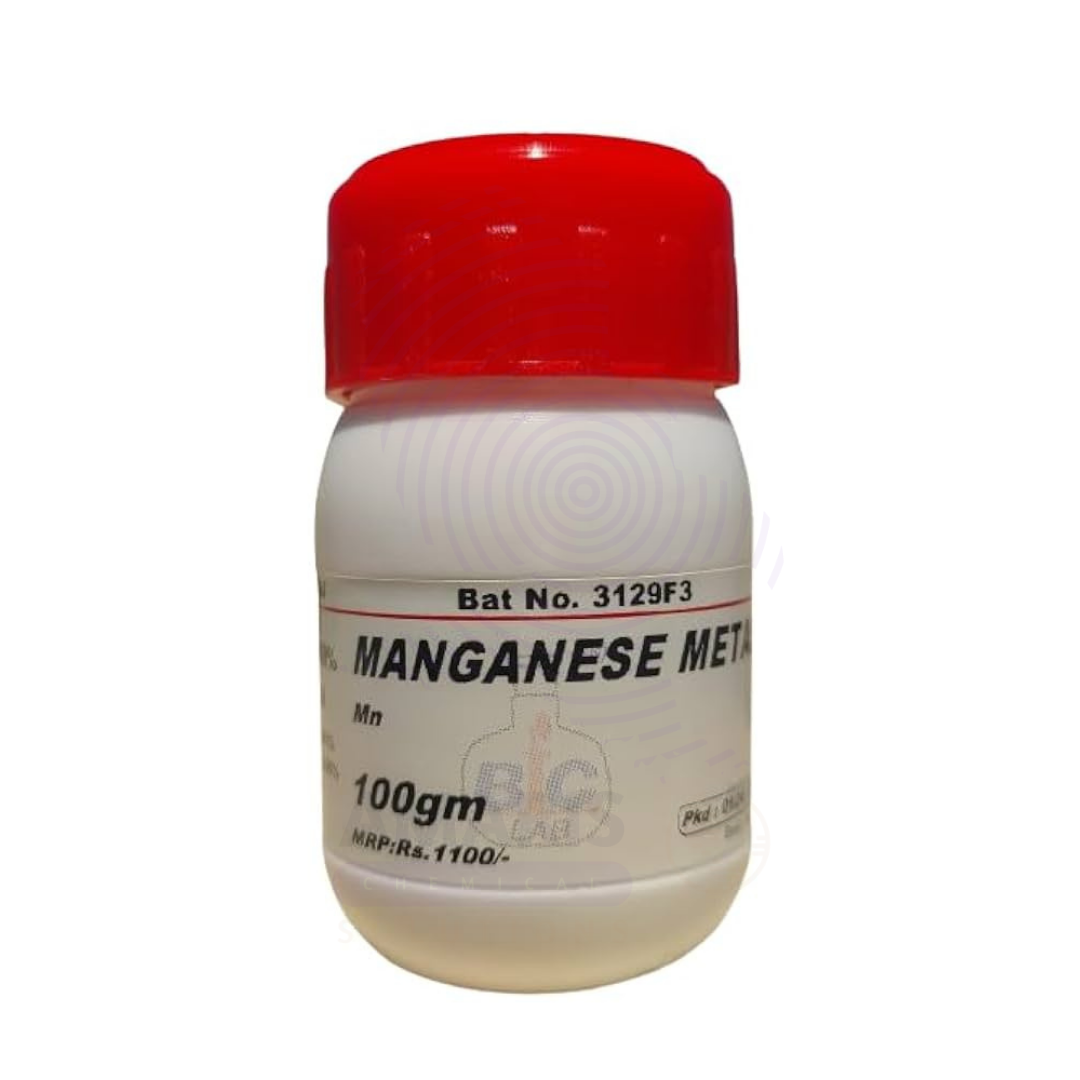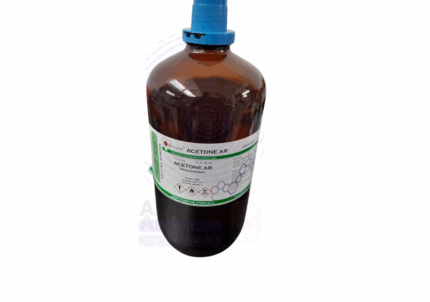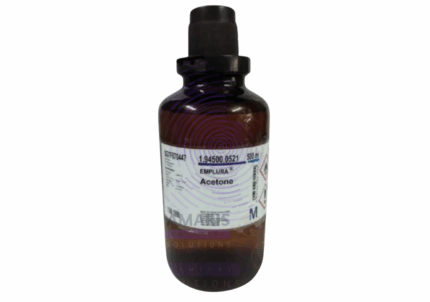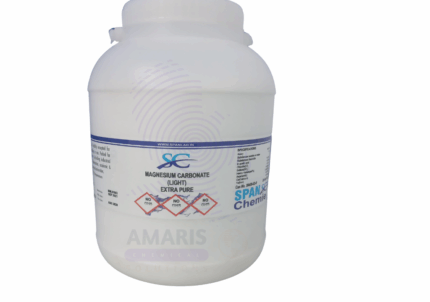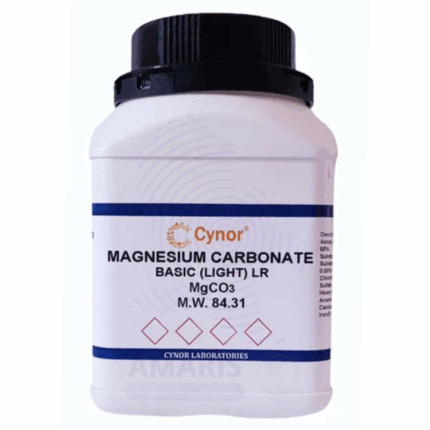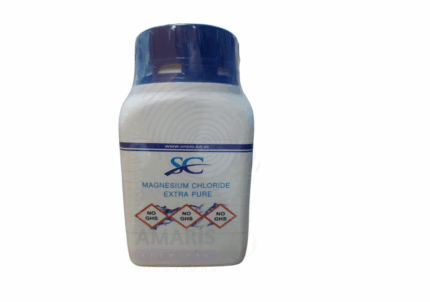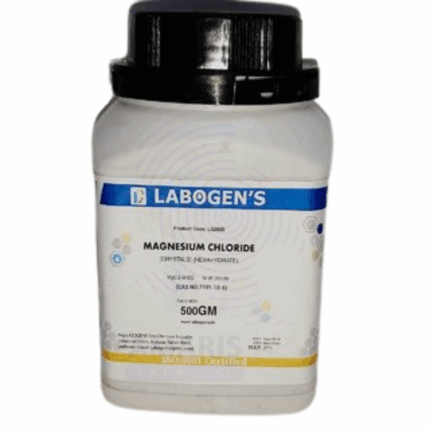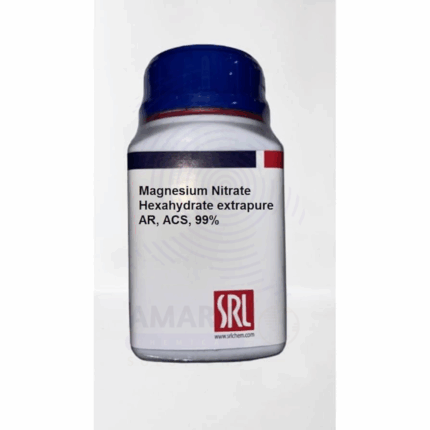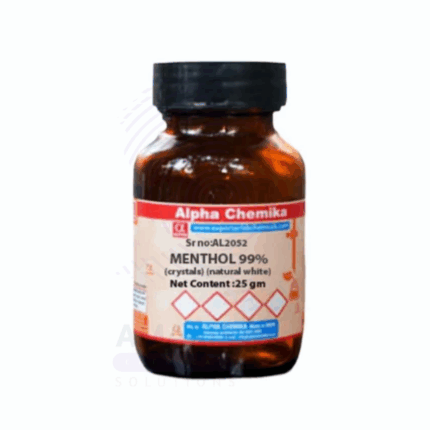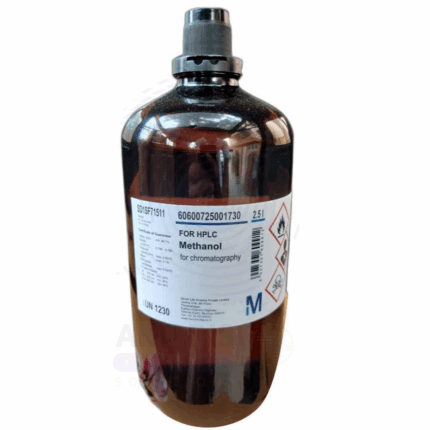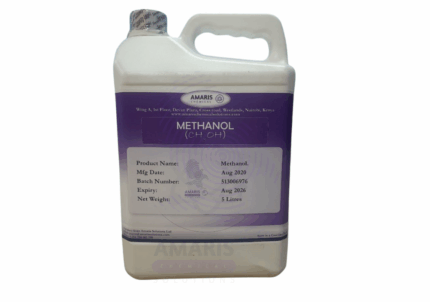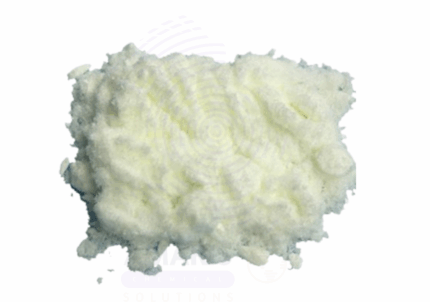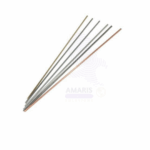

Manganese Metal Powder Extra Pure
$ 20.22 Original price was: $ 20.22.$ 20.12Current price is: $ 20.12.
Manganese Metal Powder Extra Pure is a fine, silvery-gray metallic powder known for its high reactivity and essential role in various chemical and metallurgical applications. In the laboratory, it is frequently used in redox reactions, alloy synthesis, and as a reagent for preparing manganese compounds. Its high surface area makes it particularly effective in catalysis and experimental procedures requiring fast reactivity. Industrially, manganese metal powder is integral to producing specialty steels and alloys, where it improves hardness, strength, and wear resistance. Its exceptional purity ensures consistent performance in research, metal refining, and advanced materials development.
Manganese Metal Powder Extra Pure
Primary Uses
- Reductant in Metallothermic Reactions:
- Acts as a strong reducing agent, particularly in preparing other metals from their oxides (e.g., in thermite-type reactions).
- Alloy Preparation Studies:
- Used in laboratory-scale experiments for making ferromanganese or stainless steel alloys, aiding materials science education and research.
Secondary Uses
- Magnetic and Catalytic Property Research:
- Studied for its magnetic properties and catalytic activity, especially in catalysis and surface science investigations.
- Battery and Energy Material Research:
- Investigated in energy storage systems, particularly in lithium battery research and hydrogen generation.
- Reactivity Demonstrations:
- Used in educational demonstrations to show metal-acid reactions, forming hydrogen gas.
| PACK SIZE |
500 grams Plastic Tin |
|---|
1. Basic Identification Attributes
- Chemical Name: Manganese Metal Powder
- Synonyms: Manganese, Mn metal
- CAS Number: 7439-96-5
- Molecular Formula: Mn
- Molecular Weight: 54.94 g/mol
- Appearance: Grey to silvery powder
- Odor: Odorless
- Solubility: Insoluble in water
- Grade: Extra Pure
2. Safety & Hazard Attributes
- GHS Classification:
- Flammable solid (if finely divided)
- Health hazard (chronic exposure)
- Hazard Statements:
- H228: Flammable solid
- H373: May cause damage to organs through prolonged or repeated exposure (inhalation)
- Precautionary Statements:
- P210: Keep away from heat/sparks/open flames
- P261: Avoid breathing dust
- P280: Wear protective gloves/eye protection/face protection
- P314: Get medical advice/attention if you feel unwell
- Personal Protective Equipment (PPE):
- Protective gloves
- Safety goggles
- Dust mask or respirator
- Lab coat
- First Aid Measures:
- Inhalation: Move person to fresh air; seek medical attention
- Skin Contact: Wash with plenty of water and soap
- Eye Contact: Rinse cautiously with water for several minutes
- Ingestion: Rinse mouth; seek medical help if discomfort occurs
- Fire Hazards:
- Finely divided powder may ignite in air
- Use Class D extinguishers (dry sand, dry powder); do not use water or CO₂
3. Storage & Handling Attributes
- Storage Conditions:
- Store in a cool, dry place
- Keep container tightly sealed
- Store away from oxidizing agents, acids, and moisture
- Handling Tips:
- Avoid generating dust
- Ground/bond containers when transferring powder
- Work in a well-ventilated area or fume hood
4. Laboratory Applications
- Primary Uses:
- Reagent in metallurgy experiments
- Reduction reactions in chemical synthesis
- Material science research involving alloy formation
- Secondary Uses:
- Component in specialty steel and alloys
- Battery technology studies
- Combustion demonstrations in educational settings
SAFETY PRECAUTIONS
Personal Protective Equipment (PPE):
- Wear a lab coat, nitrile gloves, and chemical safety goggles.
- Use a dust mask or work under a fume hood to prevent inhalation of fine particles.
Handling:
- Avoid contact with eyes, skin, and clothing.
- Prevent dust formation and avoid inhalation.
- Handle in an environment free from ignition sources.
- Wash thoroughly after handling.
Storage:
- Store in a cool, dry, and well-ventilated area.
- Keep the container tightly sealed and away from acids, oxidizing agents, and moisture.
- Protect from sparks, heat, and static discharge.
FIRST AID MEASURES
Inhalation:
- Move to fresh air immediately.
- Seek medical attention if symptoms such as coughing or shortness of breath occur.
Skin Contact:
- Wash thoroughly with soap and water.
- Remove contaminated clothing.
- Get medical advice if irritation develops.
Eye Contact:
- Rinse eyes with plenty of water for at least 15 minutes.
- Remove contact lenses if applicable.
- Seek medical attention if irritation persists.
Ingestion:
- Rinse mouth with water.
- Do not induce vomiting.
- Get medical help if feeling unwell.
FIRE FIGHTING MEASURES
Flammability:
- Flammable as a fine powder; may pose dust explosion risk.
- Avoid sparks or open flames.
Extinguishing Media:
- Use a Class D fire extinguisher (dry powder).
- Do not use water or CO₂—may react violently.
Hazardous Combustion Products:
- Emits manganese oxides when burned.
Firefighter Protection:
- Use self-contained breathing apparatus (SCBA) and full protective clothing.


 Preservatives(food)
Preservatives(food) Flavor Enhancers
Flavor Enhancers Acidulants
Acidulants Sweeteners
Sweeteners Antioxidants
Antioxidants Colorants(food)
Colorants(food) Nutraceutical Ingredients (food)
Nutraceutical Ingredients (food) Nutrient Supplements
Nutrient Supplements Emulsifiers
Emulsifiers
 Collectors
Collectors Dust Suppressants
Dust Suppressants Explosives and Blasting Agents
Explosives and Blasting Agents Flocculants and Coagulants
Flocculants and Coagulants Frothers
Frothers Leaching Agents
Leaching Agents pH Modifiers
pH Modifiers Precious Metal Extraction Agents
Precious Metal Extraction Agents
 Antioxidants(plastic)
Antioxidants(plastic) Colorants (Pigments, Dyes)
Colorants (Pigments, Dyes) Fillers and Reinforcements
Fillers and Reinforcements Flame Retardants
Flame Retardants Monomers
Monomers Plasticizers
Plasticizers Polymerization Initiators
Polymerization Initiators Stabilizers (UV, Heat)
Stabilizers (UV, Heat)
 Antifoaming Agents
Antifoaming Agents Chelating Agents
Chelating Agents Coagulants and Flocculants
Coagulants and Flocculants Corrosion Inhibitors
Corrosion Inhibitors Disinfectants and Biocides
Disinfectants and Biocides Oxidizing Agents
Oxidizing Agents pH Adjusters
pH Adjusters Scale Inhibitors( water)
Scale Inhibitors( water)
 Antioxidants(cosmetic)
Antioxidants(cosmetic) Emollients
Emollients Fragrances and Essential Oils
Fragrances and Essential Oils Humectants
Humectants Preservatives
Preservatives Surfactants(cosmetic)
Surfactants(cosmetic) Thickeners
Thickeners UV Filters
UV Filters
 Fertilizers
Fertilizers Soil Conditioners
Soil Conditioners Plant Growth Regulators
Plant Growth Regulators Animal Feed Additives
Animal Feed Additives Biostimulants
Biostimulants Pesticides (Herbicides, Insecticides, Fungicides)
Pesticides (Herbicides, Insecticides, Fungicides)
 Active Pharmaceutical Ingredients (APIs)
Active Pharmaceutical Ingredients (APIs) Excipients
Excipients Solvents(pharmaceutical)
Solvents(pharmaceutical) Antibiotics
Antibiotics Antiseptics and Disinfectants
Antiseptics and Disinfectants Vaccine Adjuvants
Vaccine Adjuvants Nutraceutical Ingredients (pharmaceutical)
Nutraceutical Ingredients (pharmaceutical) Analgesics & Antipyretics
Analgesics & Antipyretics
 Analytical Reagents
Analytical Reagents Solvents(lab)
Solvents(lab) Chromatography Chemicals
Chromatography Chemicals Spectroscopy Reagents
Spectroscopy Reagents microbiology-and-cell-culture-reagents
microbiology-and-cell-culture-reagents Molecular Biology Reagents
Molecular Biology Reagents Biochemical Reagents
Biochemical Reagents Inorganic and Organic Standards
Inorganic and Organic Standards Laboratory Safety Chemicals
Laboratory Safety Chemicals Specialty Laboratory Chemicals(Special Laboratory Equipment)
Specialty Laboratory Chemicals(Special Laboratory Equipment)
 Demulsifiers
Demulsifiers Hydraulic Fracturing Fluids
Hydraulic Fracturing Fluids Scale Inhibitors(oil)
Scale Inhibitors(oil) Surfactants(oil)
Surfactants(oil) Drilling Fluids
Drilling Fluids
 Dyes and Pigments
Dyes and Pigments Bleaching Agents
Bleaching Agents Softening Agents
Softening Agents Finishing Agents
Finishing Agents Antistatic Agents
Antistatic Agents
 Admixtures
Admixtures Waterproofing Agents
Waterproofing Agents Sealants and Adhesives
Sealants and Adhesives Curing Compounds
Curing Compounds Concrete Repair Chemicals
Concrete Repair Chemicals Anti-Corrosion Coatings
Anti-Corrosion Coatings
 Surfactants(cleaning)
Surfactants(cleaning) Builders
Builders Enzymes
Enzymes Solvents (Cleaning)
Solvents (Cleaning) Fragrances
Fragrances
 Electronic Chemicals
Electronic Chemicals Catalysts
Catalysts Lubricants
Lubricants Photographic Chemicals
Photographic Chemicals Refrigerants
Refrigerants Automotive chemicals
Automotive chemicals Pyrotechnic Chemicals
Pyrotechnic Chemicals
 Biodegradable Surfactants
Biodegradable Surfactants Bio-based Solvents
Bio-based Solvents Renewable Polymers
Renewable Polymers Carbon Capture Chemicals
Carbon Capture Chemicals Wastewater Treatment Chemicals
Wastewater Treatment Chemicals
 Pigments
Pigments Solvents(paint)
Solvents(paint) Specialty Coatings
Specialty Coatings Binders/Resins
Binders/Resins Additives
Additives Driers
Driers Anti-Corrosion Agents
Anti-Corrosion Agents Functional Coatings
Functional Coatings Application-Specific Coatings
Application-Specific Coatings
 Fresh Herbs
Fresh Herbs Ground Spices
Ground Spices Whole Spices
Whole Spices Spice Blends
Spice Blends Dried Herbs
Dried Herbs
 Leavening Agents
Leavening Agents Dough Conditioners
Dough Conditioners Flour Treatments
Flour Treatments Fat Replacers
Fat Replacers Decoratives
Decoratives Preservatives(baking)
Preservatives(baking)
 Plasticizers & Softeners
Plasticizers & Softeners Reinforcing Agents
Reinforcing Agents Adhesion Promoters
Adhesion Promoters Vulcanizing Agents
Vulcanizing Agents Antidegradants
Antidegradants Blowing Agents
Blowing Agents Fillers & Extenders
Fillers & Extenders Accelerators & Retarders
Accelerators & Retarders